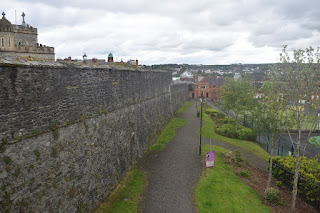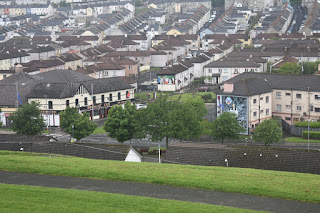We spent the next two days driving along the beautiful, wild Antrim coast. I had been told its one of the most beautiful coast drives in the world, and, although it was our first, it did not disappoint.
We spent the first morning at the Titanic Belfast exhibit. This was an interesting museum, covering, yes, the Titanic, which was built in Belfast. The focus, though, was more on the industrial history of Belfast, which was/is known for its linen mills and shipbuilding. We spent a couple hours on a rainy morning. Truth be told, this could be an exhibit at a museum anywhere in the world, John said. It didn't need its own building. But we did enjoy what we learned.
These posts outline the slips where Titanic, and her sister ship, Olympic, were built.
Titanic was built on the right side of the dock, looking down from this window.
First class cabin. So many industries were present in Belfast in the first decade of the 20th century; cloth, shipbuilding, woodworking, glass works. All these drew Harland and Wolff, the company that built her, to Belfast. Everything they needed was there.
After acquiring coffee, and glimpsing a flying whale,
we headed down the road.
Our next stop was Carrickfergus, a town about 11 miles from Belfast, along the Belfast Lough. We wanted to see castles, and they had one there.
Carrickfergus Castle was built in 1177 by John de Courcy, (see, I told you we'd talk about him, later) a Norman adventurer knight. He came north from Dublin, conquered Ulster, and ruled there as a petty king until another adventurer booted him out about 30 years later. The Castle was a military installation until 1928; more than 800 years of service!
The crane below is part of a project that (kept us from seeing the keep and) uses historical methods (minus the crane) to restore the roof. I would love to come back and see it. It made me think of Notre Dame; they're using wood for the roof, here, because that's what would have been used at the time.
We felt so safe with Godric on the crossbow.
Cannons from the time of George III. I imagine they were ready to fire on John Paul Jones, who won a naval battle here in the early part of the Revolutionary War. Or War for Independence, depending on your political stripe.
A view of the Lough.
We got to see more of the Lough further down the road, at The Gobbins. This is a tourist attraction that involves guided hiking tours along the water. High above the water, sometimes. It was fun...in a thrill-seeking sort of way. And there were puffins! There were all kinds of birds in rookeries along the way. No seals, or whales, though.
The deceitfully gentle walk down to the path. Coming back up this thing kicked our butts.
You gotta feel safe on a trail that blocks you from falling.
A rookery.
Yet another spot where the trail seemed so...safe.
But the puffins were comfy! Except for the one that kept flying. I think he wanted to escape, but knew he shouldn't leave Mrs Puffin and the Pufflets behind.
This was just one of many picturesque moments.
After the hike, our guide suggested a pub north of us, called the Londonderry Arms. Its notable in that it was once owned by Sir Winston Churchill, and his picture and some memorabilia hang in the lounge. The food was good!
A scenic drive took us to our next inn, where we met Casper, the friendly dog, and had a lovely night's rest.










































